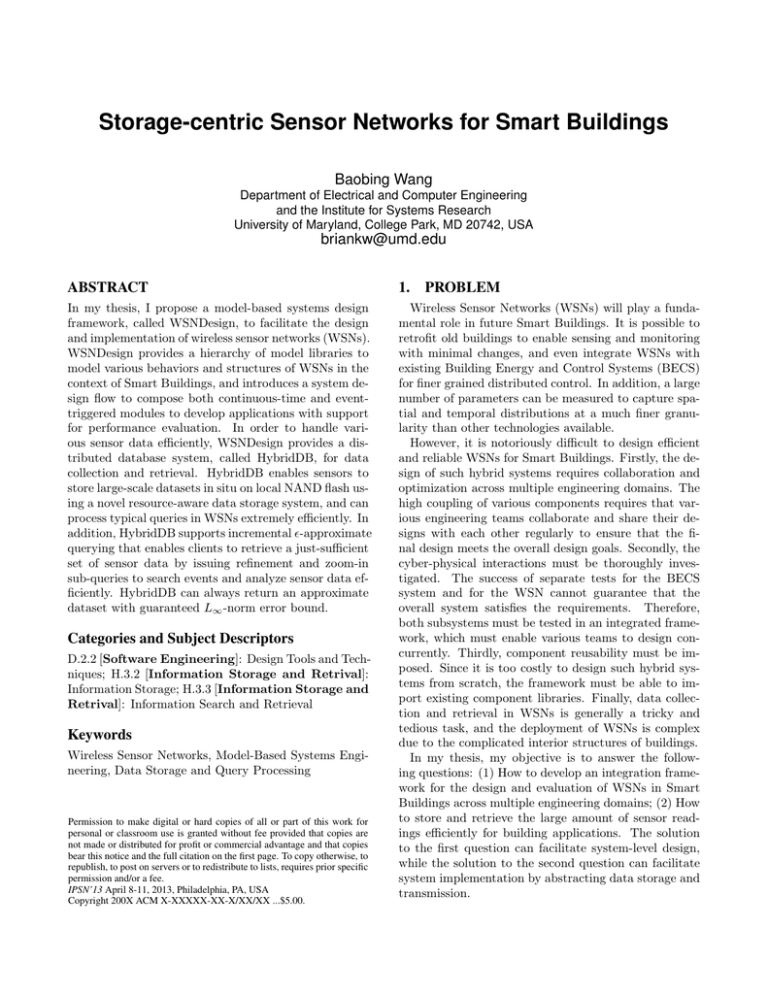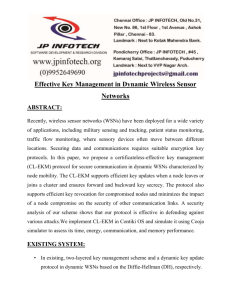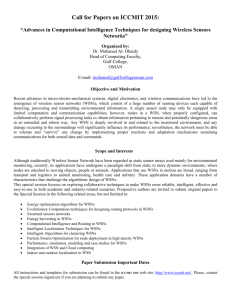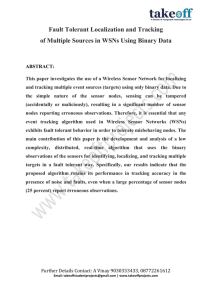Storage-centric Sensor Networks for Smart Buildings Baobing Wang
advertisement

Storage-centric Sensor Networks for Smart Buildings Baobing Wang Department of Electrical and Computer Engineering and the Institute for Systems Research University of Maryland, College Park, MD 20742, USA briankw@umd.edu ABSTRACT 1. In my thesis, I propose a model-based systems design framework, called WSNDesign, to facilitate the design and implementation of wireless sensor networks (WSNs). WSNDesign provides a hierarchy of model libraries to model various behaviors and structures of WSNs in the context of Smart Buildings, and introduces a system design flow to compose both continuous-time and eventtriggered modules to develop applications with support for performance evaluation. In order to handle various sensor data efficiently, WSNDesign provides a distributed database system, called HybridDB, for data collection and retrieval. HybridDB enables sensors to store large-scale datasets in situ on local NAND flash using a novel resource-aware data storage system, and can process typical queries in WSNs extremely efficiently. In addition, HybridDB supports incremental -approximate querying that enables clients to retrieve a just-sufficient set of sensor data by issuing refinement and zoom-in sub-queries to search events and analyze sensor data efficiently. HybridDB can always return an approximate dataset with guaranteed L∞ -norm error bound. Wireless Sensor Networks (WSNs) will play a fundamental role in future Smart Buildings. It is possible to retrofit old buildings to enable sensing and monitoring with minimal changes, and even integrate WSNs with existing Building Energy and Control Systems (BECS) for finer grained distributed control. In addition, a large number of parameters can be measured to capture spatial and temporal distributions at a much finer granularity than other technologies available. However, it is notoriously difficult to design efficient and reliable WSNs for Smart Buildings. Firstly, the design of such hybrid systems requires collaboration and optimization across multiple engineering domains. The high coupling of various components requires that various engineering teams collaborate and share their designs with each other regularly to ensure that the final design meets the overall design goals. Secondly, the cyber-physical interactions must be thoroughly investigated. The success of separate tests for the BECS system and for the WSN cannot guarantee that the overall system satisfies the requirements. Therefore, both subsystems must be tested in an integrated framework, which must enable various teams to design concurrently. Thirdly, component reusability must be imposed. Since it is too costly to design such hybrid systems from scratch, the framework must be able to import existing component libraries. Finally, data collection and retrieval in WSNs is generally a tricky and tedious task, and the deployment of WSNs is complex due to the complicated interior structures of buildings. In my thesis, my objective is to answer the following questions: (1) How to develop an integration framework for the design and evaluation of WSNs in Smart Buildings across multiple engineering domains; (2) How to store and retrieve the large amount of sensor readings efficiently for building applications. The solution to the first question can facilitate system-level design, while the solution to the second question can facilitate system implementation by abstracting data storage and transmission. Categories and Subject Descriptors D.2.2 [Software Engineering]: Design Tools and Techniques; H.3.2 [Information Storage and Retrival]: Information Storage; H.3.3 [Information Storage and Retrival]: Information Search and Retrieval Keywords Wireless Sensor Networks, Model-Based Systems Engineering, Data Storage and Query Processing Permission to make digital or hard copies of all or part of this work for personal or classroom use is granted without fee provided that copies are not made or distributed for profit or commercial advantage and that copies bear this notice and the full citation on the first page. To copy otherwise, to republish, to post on servers or to redistribute to lists, requires prior specific permission and/or a fee. IPSN’13 April 8-11, 2013, Philadelphia, PA, USA Copyright 200X ACM X-XXXXX-XX-X/XX/XX ...$5.00. PROBLEM 2. APPROACH In the first part of my thesis, I propose a model-based systems design framework, called WSNDesign, which is SysML-centric with four key features. Firstly, WSNDesign provides model libraries to model various behaviors and structures of WSNs in the context of Smart Buildings [1]. Event-triggered components are either modeled in SysML Statechart Diagrams, or imported from existing TinyOS libraries. Continuous-time components are modeled in Modelica and their behaviors are described by differential equations, which are then transformed and imported to WSNDesign. Therefore, with the help of WSNDesign, system engineers can take advantage of many existing TinyOS and Modelica libraries, rather than design everything from scratch. Secondly, WSNDesign can estimate the performance of designed systems, providing instant feedback to system engineers to quickly explore the performance tradeoffs space. In WSNDesign, each component has a performance model described using SysML Parametric Diagrams. System overall performance can be calculated by traversing the system structure tree. Thirdly, WSNDesign can generate simulation codes and configuration scripts directly from system models. Although theoretical analysis provides immediate performance results, accuracy is often sacrificed due to oversimplifications, especially for large complex systems. With code generation, WSNDesign can save system engineers the trouble of writing simulation codes manually. WSNDesign integrates the existing widely accepted simulators to increase the confidence of the simulation results. Finally, WSNDesign provides an interactive tool to reduce the complexity of system analysis using summary propagation on factor graphs transformed from SysML Parametric Diagrams [4], and expose a sequence of design choices to system designers to provide instant feedback about the influence of a design decision on the complexity of system analysis. In the second part of my thesis, I design and implement HybridDB [2], an efficient distributed database system for flash-based storage-centric WSNs. HybridDB exploits a novel resource-aware data storage system, called HybridStore [3], to store and query sensor data in situ on each sensor mote. HybridStore has three key features. Firstly, it takes advantage of the on-board randomaccessible NOR flash to guarantee that all NAND pages used by it are fully occupied and written in a purely sequential fashion, and expensive in-place updates and out-of-place writes to an existing NAND page are completely avoided. Secondly, HybridStore can process typical joint queries involving both time windows and key value ranges as filter conditions extremely efficiently. Finally, HybridStore can trivially support data aging without any extra overhead, and provides an efficient failure recovery mechanism that guarantees the highest level of data consistency without the need for any checkpoint. Based on HybridStore, HybridDB provides the support for incremental -approximate querying that enables clients to retrieve a just-sufficient set of readings by issuing sub-queries with decreasing error-bounds. HybridDB will return an approximate dataset with arbitrary L∞ -norm error bound, after applying temporal approximate locally on each sensor, and spatial approximate in the neighborhood on the proxy. In addition, HybridDB exploits an adaptive error distribution mechanism between temporal and spatial approximate for trade-offs of energy consumption between sensors and the proxy, and response times between the current subquery and following sub-queries. My implementation of HybridDB in TinyOS 2.1 can be transformed and imported to WSNDesign as a part of the model libraries. Acknowledgments I am deeply grateful to my advisor, Prof. John S. Baras, for his inspirational, supportive and patient guidance, and insightful discussions. In addition, I have been very privileged to collaborate with Dr. Shah-An Yang (Google Inc.) over the past two years. Biography Mr. Baobing Wang joined the Department of Electrical and Computer Engineering at the University of Maryland, College Park in 2009, and is expected to graduate in May 2014. He is working with Prof. John S. Baras on system modeling, design and evaluation for WSNs. Mr. Wang received his B.S. degree and M.Phil. degree both in Computer Science in 2006 and 2009, respectively. 3. REFERENCES [1] B. Wang and J. S. Baras. Integrated modeling and simulation framework for wireless sensor networks. In IEEE 21st WETICE, pages 1 – 6, 2012. [2] B. Wang and J. S. Baras. HybridDB: An efficient database system supporting incremental -approximate querying for storage-centric sensor networks. ACM Trans. on Sensor Networks (submitted), pages 1 – 35, 2013. [3] B. Wang and J. S. Baras. HybridStore: An efficient data management system for hybrid flash-based sensor devices. In the 10th European Conference on Wireless Sensor Networks (EWSN, to appear), pages 1 – 16, 2013. [4] S.-A. Yang, B. Wang, and J. S. Baras. Interactive tree decomposition tool for reducing system analysis complexity. In the 11th Annual Conference on Systems Engineering Research (CSER, to appear), pages 1 – 10, 2013.




